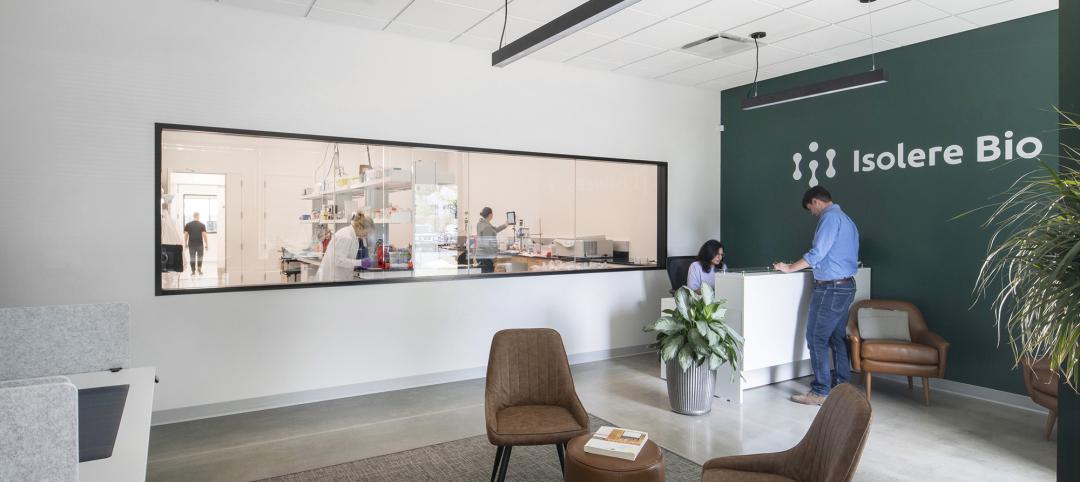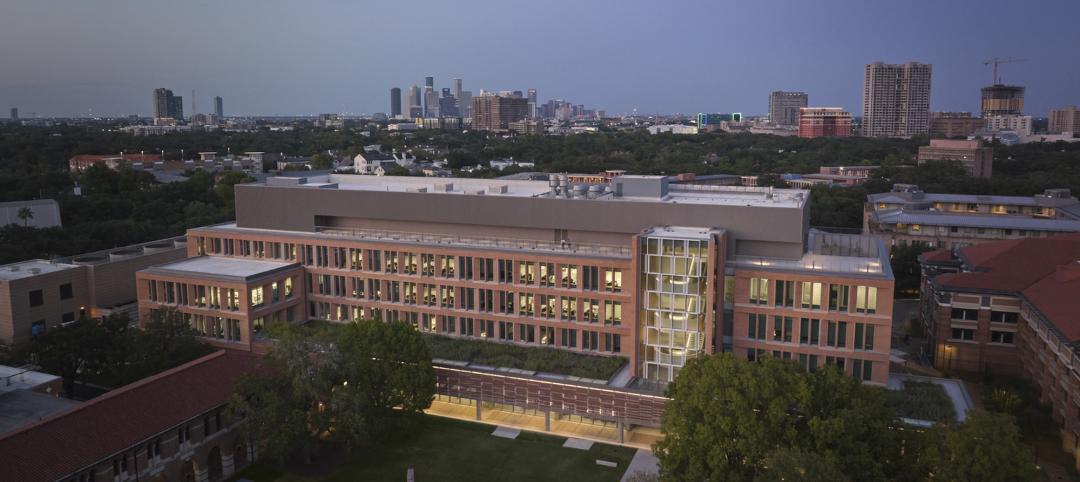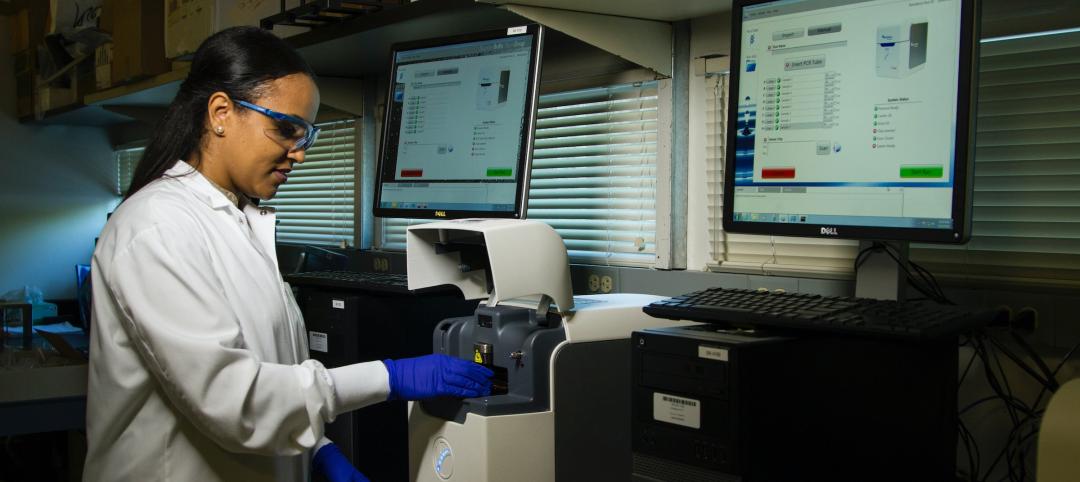The mushrooming global demand for lab space has prompted AEC firms and their developer clients to rethink how science buildings can be designed and constructed quicker and efficiently.
These buildings need “to be optimized for a tenant; concerns about vibration, ventilation, containment, and specialized equipment go beyond the scope of traditional workplaces,” wrote Chad Yoshinobu, AIA, LEED BD+C, Design Director, and a global leader in Gensler’s science practice in Seattle.
Enter NEXT, a prototype that Gensler and the engineering firms Buro Happold and KPFF have developed, with performance metrics backed up by data.
The research project was funded by Gensler Research Institute, and was designed on the specific site within Seattle’s Uptown Arts District to be 250,000 sf and eight stories tall. The project had three goals: to make this space more than just a container for people, to increase product differentiation for competitive marketing, and to offer solutions that prioritize decarbonization as a method of resilience.
Mass timber was a seminal building material for this project, mainly because it is well-suited to off-site modular construction at a nearby factory and can be delivered as a kit of parts, explained Yoshinobu.
“This approach would be 30 percent faster and 10 percent cheaper to construct than a conventional concrete building,” he estimated. With 85 percent fewer deliveries to the site and a 75 percent reduction in construction waste, NEXT emits 80 percent less carbon to build than a conventional concrete lab building. This amounts to a savings of approximately 5,200 total metric tons of CO2.
NEXT deploys an all-electric heat pump chiller (EL1) system that Gensler stated is more efficient than a natural gas system in all locations and sectors. All-electric systems result in lower building Energy Use Intensity (EUI) in all markets and achieve zero carbon emissions on a clean grid. In total, NEXT produces 50 percent less greenhouse gas emissions and uses 30 percent less energy annually than a conventional lab building.
FLEXIBLE LAYOUT
Lab benches and vibrations in the floor plate typically determine a lab space’s layout. The NEXT team created a grid at 33 by 33 ft, which Yoshinobu contended is “optimal” for a lab bench layout because of the flexibility it affords tenants to orient the benches as they see fit. The building core is moved from the center to the side of the building, allowing tenants more layout flexibility with far fewer obstructions.
The size of this grid in mass timber doesn’t work well with vibration. “So we partnered with our engineering partner KPFF to make it work,” said Yoshinobu, to achieve a vibration of 6,000 MIPS, a go-to standard for most lab buildings, by implementing a structural frame that acts as an ecosystem between the size of the columns, girders, beams, CLT floors, and concrete topping slab.
CONNECTING WITH OUTDOORS AND COMMUNITY

NEXT also places a premium on natural ventilation and outdoor spaces. Multiple operable windows give the workplace more access to fresh air. Seattle’s temperate climate is conducive to natural ventilation, and NEXT is designed so more than one-third of total occupied work hours can be in natural ventilation mode. That leads to energy savings of 30 percent compared to a conventional lab building.
According to the latest Gensler U.S. Workplace Survey, science workers ranked outdoor space as their top workplace amenity. Each floor of the NEXT concept has direct access to outdoor spaces. The building’s fire stair has been turned into a wellness amenity, too, by moving it to the perimeter, and flooding the stairwell with daylight and views. The stair is also an alternative to using elevators.
This multipurpose venue was created in partnership with the Uptown Arts and Cultural Coalition to provide flexible spaces for young musicians, art education, theater, and practice/performance space. The restaurant incubator gives minority entrepreneurs the opportunity to launch their businesses, while a shared kitchen space allows for multiple food venues to enhance the neighborhood food scene. “These efforts will create more cultural diversity within the Uptown District,” wrote Yoshinobu.
He told BD+C that since releasing its research findings, Gensler has received calls from clients and developers “asking us to explore the attributes of this idea on their particular sites.”
Related Stories
University Buildings | Feb 21, 2024
University design to help meet the demand for health professionals
Virginia Commonwealth University is a Page client, and the Dean of the College of Health Professions took time to talk about a pressing healthcare industry need that schools—and architects—can help address.
Urban Planning | Feb 5, 2024
Lessons learned from 70 years of building cities
As Sasaki looks back on 70 years of practice, we’re also looking to the future of cities. While we can’t predict what will be, we do know the needs of cities are as diverse as their scale, climate, economy, governance, and culture.
Laboratories | Feb 5, 2024
DOE selects design-build team for laboratory focused on clean energy innovation
JE Dunn Construction and SmithGroup will construct the 127,000-sf Energy Materials and Processing at Scale (EMAPS) clean energy laboratory in Colorado to create a direct path from lab-scale innovations to pilot-scale production.
Laboratories | Jan 25, 2024
Tactical issues for renovating university research buildings
Matthew Plecity, AIA, ASLA, Principal, GBBN, highlights the connection between the built environment and laboratory research, and weighs the benefits of renovation vs. new construction.
Laboratories | Jan 22, 2024
Speculative vs purpose-built labs: Pros and cons
Hanbury's George L. Kemper, AIA and R. David Cole, AIA share the unique advantages and challenges of both spec. and purpose-build labs.
University Buildings | Jan 18, 2024
Houston’s Rice University opens the largest research facility on its core campus
Designed by Skidmore, Owings & Merrill (SOM), the 251,400-sf building provides students and researchers with state-of-the-art laboratories, classrooms, offices, and a cafe, in addition to multiple gathering spaces.
Healthcare Facilities | Jan 7, 2024
Two new projects could be economic catalysts for a central New Jersey city
A Cancer Center and Innovation district are under construction and expected to start opening in 2025 in New Brunswick.
Laboratories | Jan 5, 2024
Office conversions are helping to meet the growing demand for life-science space
Ware Malcomb and Rock Creek Property Group led the team that recently completed the adaptive reuse of two office buildings in Maryland.
Mass Timber | Jan 2, 2024
5 ways mass timber will reshape the design of life sciences facilities
Here are five reasons why it has become increasingly evident that mass timber is ready to shape the future of laboratory spaces.
Giants 400 | Nov 28, 2023
Top 55 Laboratory Construction Firms for 2023
Whiting-Turner, DPR Construction, STO Building Group, Skanska, and Hensel Phelps top BD+C's ranking of the nation's largest laboratory general contractors and construction management (CM) firms for 2023, as reported in Building Design+Construction's 2023 Giants 400 Report.

















